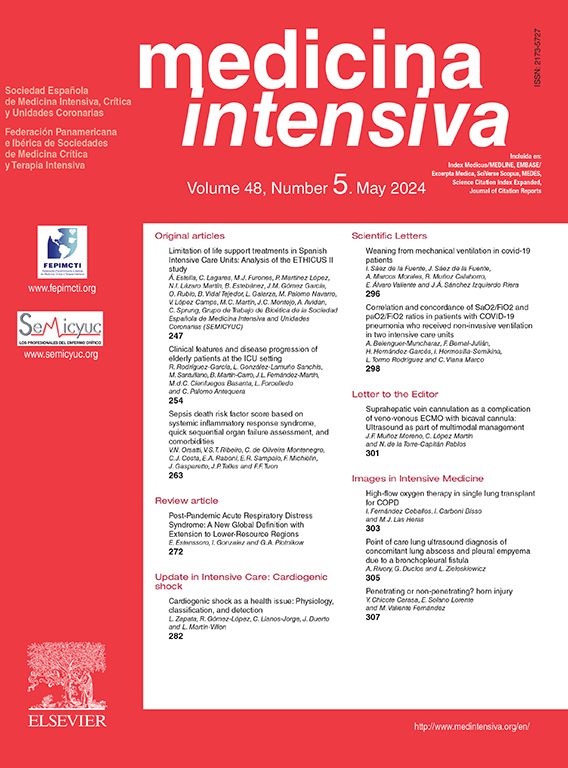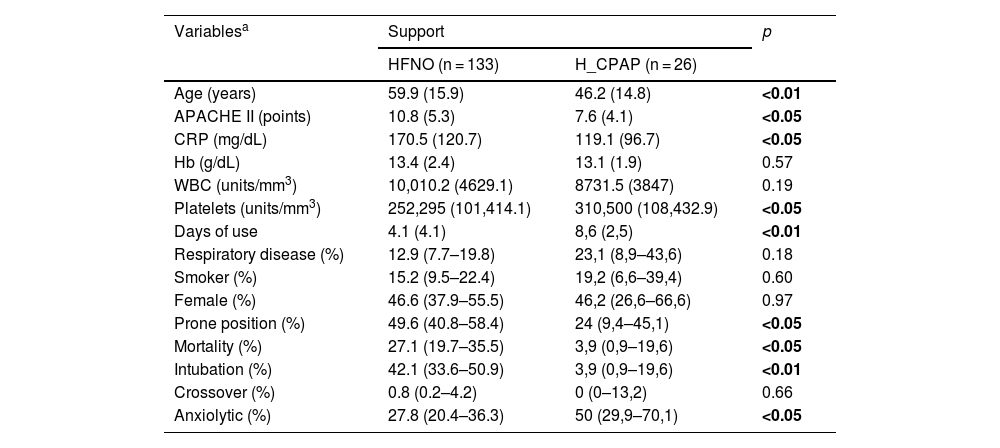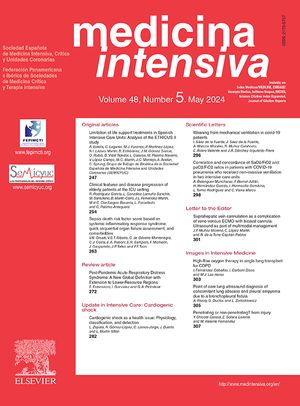To determine the relative effectiveness of Helmet-CPAP (H_CPAP) with respect to high-flow nasal cannula oxygen therapy (HFNO) in avoiding greater need for intubation or mortality in a medium complexity hospital in Chile during the year 2021.
DesignCohort analytical study, single center.
SettingUnits other than intensive care units.
PatientsRecords of adults with mild to moderate hypoxemia due to coronavirus type 2.
InterventionsNone.
Main variables of interestNeed for intubation or mortality.
Results159 patients were included in the study, with a ratio by support of 2:10 (H_CPAP:HFNO). The 46.5% were women, with no significant differences by sex according to support (p = 0.99, Fisher test). The APACHE II score, for HFNO, had a median of 10.5, 3.5 units higher than H_CPAP (p < 0.01, Wilcoxon rank sum). The risk of intubation in HFNO was 42.1% and in H_CPAP 3.8%, with a significant risk reduction of 91% (95% CI: 36.9%–98.7%; p < 0.01). APACHE II does not modify or confound the support and intubation relationship (p > 0.2, binomial regression); however, it does confound the support and mortality relationship (p = 0.82, RR homogeneity test). Despite a 79.1% reduction in mortality risk with H_CPAP, this reduction was not statistically significant (p = 0.11, binomial regression).
ConclusionsThe use of Helmet CPAP, when compared to HFNO, was an effective therapeutic ventilatory support strategy to reduce the risk of intubation in patients with mild to moderate hypoxemia caused by coronavirus type 2 in inpatient units other than intensive care. The limitations associated with the difference in size, age and severity between the arms could generate bias.
Determinar la efectividad relativa del Helmet-CPAP (H_CPAP) respecto a la oxigenoterapia con cánula nasal de alto flujo (CNAF) para evitar mayor necesidad de intubación o mortalidad en un hospital de mediana complejidad en Chile durante el año 2021.
DiseñoEstudio analítico de cohorte, en centro único.
ÁmbitoUnidades clínicas que no sean de cuidados intensivos.
PacientesRegistros de adultos con hipoxemia leve a moderada debida a coronavirus tipo 2.
IntervencionesNinguna.
Principales variables de interésNecesidad de intubación o mortalidad.
ResultadosSe incluyeron 159 pacientes en el estudio, con una razón por soporte de 2:10 (H_CPAP:HFNO). El 46,5% fueron mujeres, sin diferencias significativas por sexo según soporte (p = 0,99, test de Fisher). La puntuación APACHE II, para CNAF, tuvo una mediana de 10,5, 3,5 unidades mayor que H_CPAP (p < 0,01, Wilcoxon rank sum). El riesgo de intubación en CNAF fue del 42,1% y en H_CPAP del 3,8%, con una reducción significativa del riesgo del 91% (IC 95%: 36,9% a 98,7%; p < 0,01). APACHE II no modifica ni confunde la relación soporte e intubación (p > 0,2, regresión binomial); sin embargo, sí confunde la relación soporte y mortalidad (p = 0,82, test de homogeneidad RR). A pesar de que se observa un 79,1% de reducción del riesgo de mortalidad con H_CPAP, esta reducción no fue estadísticamente significativa (p = 0,11, regresión binomial).
ConclusionesEl uso de Helmet CPAP, al compararse con CNAF, fue una estrategia de soporte ventilatorio terapéutico eficaz para reducir el riesgo de intubación en pacientes con hipoxemia leve a moderada causada por coronavirus tipo 2 en unidades de hospitalización distintas de cuidados intensivos. Las limitaciones asociadas a la diferencia de tamaño, edad y gravedad entre los brazos de estudio podrían generar sesgo.
Article
Go to the members area of the website of the SEMICYUC (www.semicyuc.org )and click the link to the magazine.










